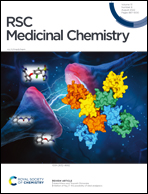Development of tumor-targeting aza-vesamicol derivatives with high affinity for sigma receptors for cancer theranostics†
Abstract
As sigma receptors are highly expressed on various cancer cells, radiolabeled sigma receptor ligands have been developed as imaging and therapeutic probes for cancer. Previously, we synthesized and evaluated a radioiodinated vesamicol derivative, 2-(4-[125I](4-iodophenyl)piperidine)cyclohexanol ((+)-[125I]pIV), and a radioiodinated aza-vesamicol derivative, trans-2-(4-(3-[125I](4-iodophenyl)propyl)piperazin-1-yl)cyclohexan-1-ol ([125I]2), as sigma-1 receptor-targeting probes. In order to obtain sigma receptor-targeting probes with superior biodistribution characteristics, we firstly synthesized twelve bromine-containing aza-vesamicol derivatives and evaluated their affinity for sigma receptors. One such derivative exhibited high selectivity for the sigma-1 receptor and another exhibited high affinity for both the sigma-1 and sigma-2 receptors. Thus, their halogen-substituted iodine- and radioiodine-containing compounds were prepared. The 125I-labeled compounds exhibited high uptake in tumor and lower uptake in non-target tissues than the two previously developed and evaluated 125I-labeled sigma receptor-targeting probes, [125I]pIV and [125I]2. Therefore, these novel radioiodine-labeled compounds should be promising as sigma receptor-targeting probes.



 Please wait while we load your content...
Please wait while we load your content...